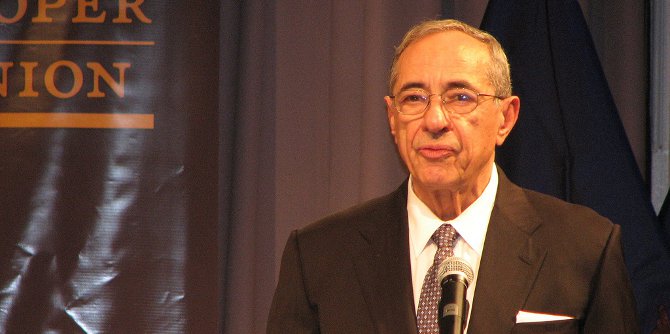 Last week, after several weeks of criticism following the tragic shooting in Charleston, South Carolina’s state legislature voted to remove the Confederate battle flag from the State Capitol. Richard Brodsky writes that such battles over the Confederate flag are not new; in 1997 Governor George Pataki ordered that flag in the New York State Capitol be removed. Though Pataki and his legislative colleagues did the right thing, it still led to a war of words with Georgia.
Last week, after several weeks of criticism following the tragic shooting in Charleston, South Carolina’s state legislature voted to remove the Confederate battle flag from the State Capitol. Richard Brodsky writes that such battles over the Confederate flag are not new; in 1997 Governor George Pataki ordered that flag in the New York State Capitol be removed. Though Pataki and his legislative colleagues did the right thing, it still led to a war of words with Georgia.
Confederate flag controversies are plentiful right now. But America has had them before and the way one of them was handled in Albany, New York is instructive.
Way back in 1997, New York Assemblywoman Earlene Hooper noticed that the Georgia state flag on display in the State Capitol’s Flag Room prominently incorporated the Confederate battle flag. The Assemblywoman has strong opinions and a willingness to act on them. She was dissuaded by the Capitol Police. A letter shortly arrived on the desk of then-Governor George Pataki asking that the flag be removed, signed by Assemblyman Jeff Aubry and Senator (later Governor) David Paterson on behalf of the Black and Puerto Rican Legislative Caucus.
Pataki is a Republican who tacked right often, but who retained attributes of the near-extinct Nelson Rockefeller wing of the GOP. By today’s anti-voting rights, anti-immigration, anti-government Republican standards, Pataki is way-out-liberal, but what is more properly called “moderate”. Pataki didn’t think twice. “It is a symbol of hatred not just for minorities or African-Americans but for all Americans who understand that we have to move together as a people with respect.”
Down came the flag, and a mini-Civil War began.
Georgia retaliated. Lieut. Gov. Pierre Howard fired the first shot: ”Governor Pataki would do well to spend his time on his alarming crime rate, cleaning up his polluted air and water and dealing with some of his festering problems, instead of seeking cheap publicity,” he said. Two Georgia Senators took the Earlene Hooper approach and without official permission took down the New York flag. Georgia’s Secretary of State was not pleased, called the Senators “childish” and restored the New York flag. The Georgia Senators did get in the last shot: “They started it.”
Hooper, Aubry and Paterson did the right thing. So did Pataki. That it took the rest of country eighteen years to catch up is truly troubling.
Credit: MPD01605 (Flickr, CC-BY-SA-2.0)
It makes you wonder what folks out there are thinking. The Confederate battle flag may be many things to many people, but it is a symbol of treason in support of legalized violence and exploitation of millions of slaves. Slavery is not an academic concept. It was a brutal and inhuman and peculiarly American system and it is a blot on American history. It cost the lives of hundreds of thousands to end it.
To make it worse it’s not like the battle flag had a long history as a symbol of Georgia and elsewhere. Like in South Carolina, the State embraced the Confederate battle flag during the Civil Rights era of fifty years ago. Before then state flags were not symbols of defiance of Yankees, and the Federal Government and African-Americans uppity enough to want to vote and live free of the Klan. Southern states embraced the Confederate battle flag because they were trying to preserve legal segregation just like they fought to preserve legal slavery.
For fierce defenders of free expression, like me, don’t worry. Neither the First Amendment nor the right to privately revere whatever one chooses requires a state to put the Confederate flag in a place of honor, any more than it would do so for a German swastika flag.
By the way, there are other depictions of the Confederate flag in the New York Capitol, in historic murals. And all across the country there are monuments and streets and plaques that honor various Confederates, anti-Semites, misogynists and others who held views that are repugnant, especially by today’s standards. As the debate grows, New York will be part of a national conversation about the balance between free speech and hate, history and advocacy. Life and history are complicated. Many great Americans were slaveholders or otherwise implicated in some awful stuff. On the one hand it’s time we examined what we honor and elevate. On the other we shouldn’t impose our current moral perspective on those who lived centuries ago, if only because no one will survive that test, and a century from now we will be called out for our present value system as well.
But well done Earlene, and Jeff and David. And you too George. There’s a real opportunity for Pataki here; the Republican presidential field has bound itself to policies and pronouncements that are Neanderthal and unpopular outside of the narrow right-wing base they are all courting. Pataki should make his swift and intelligent response to the Confederate flag a campaign issue. It won’t do him much good in the South but he was never going to do well there anyway. But in places like New Hampshire there are Republicans tired of being defined by Ted Cruz and Rush Limbaugh. It would be smart and refreshing to mobilize those folks, and to force the other candidates to discuss their view of treason, slavery and their symbols. There are more votes than you think for a Republican willing to remind the GOP that it is the party of Lincoln, not Strom Thurmond and Donald Trump.
A version of this article originally appeared at the Albany Times Union.
Please read our comments policy before commenting.
Note: This article gives the views of the author, and not the position of USApp– American Politics and Policy, nor of the London School of Economics.
Shortened URL for this post: http://bit.ly/1M8yJ8g
______________________
 Richard Brodsky – Demos & NYU Wagner
Richard Brodsky – Demos & NYU Wagner
Richard Brodsky served 14 terms as a New York State Assemblyman, retiring in 2010. He is currently a Senior Fellow at Demos, a progressive think tank in New York City, and a Senior Fellow at New York University’s Wagner School of Public Administration. His years of public service focused on government reform, environmental protection and economic policy. He is also a lawyer and a journalist. Follow Richard Brodsky on Twitter:www.twitter.com/richardbrodsky.








Thank you for posting this blog. That is a piece of NY history that many were either unaware of OR perhaps forgotten about. I will add that the two biggest crimes in human history were genocide and slavery, and they must never be repeated. Violence, exploitation of humans, hatred, etc…must be condemned, and those who supported it in the past or currently support it or will support it in the future must also be condemned.
As for your article, you state that the Confederate battle flag symbolized “legalized violence and exploitation of millions of slaves. Slavery is not an academic concept. It was a brutal and inhuman and peculiarly American system and it is a blot on American history.” My question/statement to this quote is that such crimes against humanity occurred before the Confederacy and after the Confederacy, and the flags of those other countries are not similarly condemned (ex. UK flag, French flag, Belgium flag, Spanish flag etc…). The examples that come to my mind include the genocide in the Western hemisphere by the Europeans upon the native populations, and the European exploitations in Africa (including the aftermaths of the Berlin Conference of 1884). So my question/statement is, should not those other countries’ flags be similarly condemned and taken down? Those other countries’ exploitations existed for a much longer period of time than the existence of the Confederate States of America. So as an academic, how do you tell students that one flag should be condemned, but the flag of other similar or greater violators is given a pass?
Please advise.